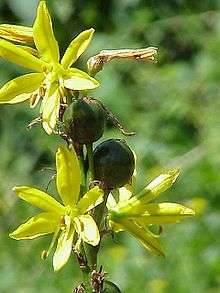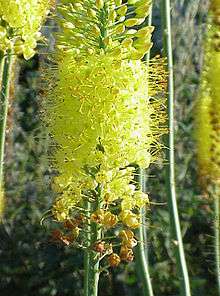Asphodeloideae
| Asphodeloideae | |
|---|---|
 | |
| Yellow Asphodel (Asphodeline lutea) | |
| Scientific classification | |
| Kingdom: | Plantae |
| Clade: | Angiosperms |
| Clade: | Monocots |
| Order: | Asparagales |
| Family: | Asphodelaceae |
| Subfamily: | Asphodeloideae |
| genera | |
|
see text | |
Asphodeloideae is a subfamily of the monocot family Asphodelaceae in the order Asparagales. It has previously been treated as a separate family, Asphodelaceae sensu stricto.[1] The family Asphodelaceae has now been proposed to be a nomen conservandum, and the proposal has been recommended for ratification in 2017. In that case, Asphodelaceae will have priority over Xanthorrhoeaceae. This is reflected in the APG IV family lists.[2]
The subfamily name is derived from the generic name of the type genus, Asphodelus. Members of group are native to Africa, central and western Europe, the Mediterranean basin, Central Asia and Australia, with one genus (Bulbinella) having some of its species in New Zealand. The greatest diversity occurs in South Africa.
The genera Aloe, Asphodelus, and Kniphofia are perhaps best known from their use in horticulture as ornamental plants.

Characters of Asphodeloideae
The Asphodeloideae are distinguished by a general presence of anthraquinones, simultaneous microsporogenesis, atypical ovules morphology, and the presence of an aril.[3] Asphodeloideae also have a characteristic secondary growth by means of a secondary thickening meristem.[3] This character, however, is also found in other taxa in the Asparagales, including Agavaceae, Iridaceae, and Xanthorrhoeoideae. It is confined to Asparagales among the monocots and is believed to have evolved independently in most families.[3]
Phylogeny of Asphodeloideae
There is agreement among many researchers that Asphodeloideae can be further divided into a monophyletic group comprising Aloe and its immediate relatives, and a nonmonophyletic group of the remaining genera.[3][4][5] The monophyletic group can be treated either as the tribe Aloeae within the subfamily Asphodeloideae or as the subfamily Alooideae within the family Asphodelaceae.[6] Aloeae or Alooideae are mainly rosulated-leaf succulents, while the other genera are not succulent. The genera in Alooideae are centered in southern Africa, while the other genera have mainly a Eurasian distribution.[5]
Alooideae
The Alooideae s.s. comprise Aloe, Astroloba, Chamaealoe, Gasteria, Haworthia, Lomatophyllum, and Poellnitzia.[3] The genera within Alooideae have several morphological characters that can be readily distinguished in the field, namely the arrangement and type of leaf and inflorescence.
Alooidae leaves are arranged in strongly tufted terminal (in arborescent species, as in Aloe barberae) or basal rosettes and are arranged in distinct ranks. Leaves are succulent and have distinctive white or concolorous tubercules. This is hypothesized to be a derived condition, possibly as a mechanical defensive mechanism to make the leaf less palatable, or to prevent heat damage in arid conditions. As well, the cross-section of the leaves are distinctly shaped in a cymbiform or crescent shape, which represents a synapomorphy for all Alooideae taxa.[4]
The inflorescence is compacted into a many-flowered spike, or a simple or branched raceme, and is apical, although can seem axillary. Stems are monopodial until an inflorescence is formed, and then it becomes sympodial; this prevents the rosette from dying as in Agave. Flowers of all taxa within Alooideae are tubular and have a fusion of petaline tepals, although the amount of fusion varies among genera.[4]
Evidence for monophyly of Alooideae is based on distinctive karyotype and characteristic leaf morphology. The Bulbine group has characteristics of Alooideae, but is not included in the group due to a lack of tubular flowers. Kniphofia is considered an outgroup of Alooideae since it has tubular flowers and a fusion of perianth segments, but it lacks succulent leaves.[4]
Aloin cells
The presence of aloin cells is a distinctive character of the Alooideae. These cells are present in all Alooideae, but are absent in most of the other genera within Asphodeloideae.[3] A well-developed cap of thin-walled parenchyma cells occurs at the phloem pole of each vascular bundle.[4] Chase posits that they are involved in secondary metabolite production,[3] but Beaumont suggests that the cells act as a storage tissue for compounds synthesized in the surrounding layer of cells.[7] The aloin cells are said to produce the characteristic thick exudate that is produced when the succulent leaf of aloe is severed.[7] The aloin cells produce anthraquinone and chromone derivatives,[7] which may be responsible for the medicinal attributes of Aloe.
List of genera
The genera listed below are from the World Checklist of Selected Plant Families,[8] with the placement in the subfamily based on APWeb as of May 2011.[6][9] Other treatments combine some of these genera into as few as seven.
- Aloe L.
- Astroloba Uitewaal
- Asphodeline Rchb.
- Asphodelus L.
- Bulbine Wolf
- Bulbinella Kunth
- Chortolirion A.Berger
- Eremurus M.Bieb.
- Gasteria Duval
- Haworthia Duval
- Jodrellia Baijnath
- Kniphofia Moench
- Lomatophyllum Willdenow – synonym of Aloe
- Poellnitzia Uitewaal – synonym of Astroloba
- Trachyandra Kunth
For a phylogeny of the family, see the phylogenetic tree at Asphodelaceae.[10]
References
- ↑ Chase, M.W.; Reveal, J.L. & Fay, M.F. (2009), "A subfamilial classification for the expanded asparagalean families Amaryllidaceae, Asparagaceae and Xanthorrhoeaceae", Botanical Journal of the Linnean Society, 161 (2): 132–136, doi:10.1111/j.1095-8339.2009.00999.x
- ↑ Angiosperm Phylogeny Group (2016). "An update of the Angiosperm Phylogeny Group classification for the orders and families of flowering plants: APG IV" (PDF). Botanical Journal of the Linnean Society. 181 (1): 1–20. doi:10.1111/boj.12385. Retrieved 2016-04-10.
- 1 2 3 4 5 6 7 Chase, M.W.; De Bruijn, A. Y.; Coz, A. V.; Reeves, C.; Rudall, P.J.; Johnson, M. A. T.; Eguiarte, L. E. (2000). "Phylogenetics of Asphodelaceae (Asparagales): An analysis of plastid rbcL and trnL-F DNA sequences". Annals of Botany. 86 (5): 935–951. doi:10.1006/anbo.2000.1262.
- 1 2 3 4 5 Smith, G. F.; B. E. Van Wyk (1991). "Generic Relationships in the Alooideae (Asphodelaceae)". Taxon. 40 (4): 557–581. doi:10.2307/1222765.
- 1 2 Treutlein, J.; G. F. Smith; B. E. van Wyl; M. Wink (2003). "Evidence for the polyphyly of Haworthia (Asphodelaceae subfamily Alooideae; Asparagales) inferred from nucleotide sequences of rbcL, matK, ITS1 and genomic fingerprinting with ISSR-PCR". Plant Biology. 5 (5): 513–521. doi:10.1055/s-2003-44793.
- 1 2 Stevens, P.F., Angiosperm Phylogeny Website: Asparagales: Asphodeloideae, retrieved 2014-11-08
- 1 2 3 Beaumont, J.; Cutler, D.F.; Reynolds, T. (1986). "Secretory tissues in the East African shrubby aloes". Botanical Journal of the Linnean Society. 92 (4): 399–403. doi:10.1111/j.1095-8339.1986.tb01439.x.
- ↑ Search for "Xanthorrhoeaceae", World Checklist of Selected Plant Families, Royal Botanic Gardens, Kew, retrieved 2013-02-25
- ↑ Grace, Olwen M.; Klopper, Ronell R.; Smith, Gideon F.; et al. (2012). "A revised generic classification for Aloe (Xanthorrhoeaceae subfam. Asphodeloideae)" (PDF). Phytotaxa. 76 (1): 7–14. doi:10.11646/phytotaxa.76.1.1.
- ↑ Dion S. Devey, Ilia Leitch, Paula J. Rudall, J. Chris Pires, Yohan Pillon, and Mark W. Chase. "Systematics of Xanthorrhoeaceae sensu lato, with an emphasis on Bulbine". Aliso 22(Monocots: Comparative Biology and Evolution):345-351. ISSN 0065-6275.
External links
| Wikimedia Commons has media related to Asphodeloideae. |
- Asphodeloideae At: Angiosperm Phylogeny Website At: Missouri Botanical Garden Website
- Asphodelaceae in L. Watson and M.J. Dallwitz (1992 onwards). The families of flowering plants: descriptions, illustrations, identification, information retrieval. Version: 9 March 2006. https://web.archive.org/web/20070103200438/http://delta-intkey.com:80/
- NCBI Taxonomy Browser
- links at CSDL, Texas
